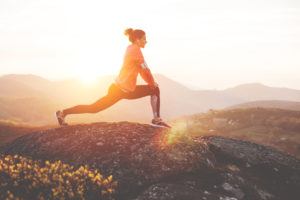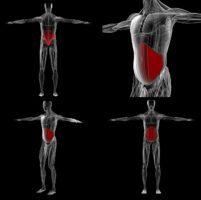Core Stability: What Is It, and How Do I Get It?
Core stability: this term is tossed around easily in fitness and sports conditioning environments. But what does it really mean? A strong core enables a stable trunk of the body, which can then make overall movement easier and more efficient. But what is “the core?” And why is core stability important? Let’s take a quick look at the core, and why stability is important in every body for movement that feels consistently fluid and easy. (And no – that’s not a feeling reserved for the young!)
What Is The Core, Really?
What is the core? Strong abdominal muscles? Yes and No. I have worked with a lot of wonderful people who have beautiful, “ripped” and rock hard abdominals, but who have movement challenges and possibly pain due to a lack of functional stability in motion. Is it the ability to “brace” or “throw your back into it?” Not so much.
In most fitness and medical circles, the body’s “inner unit core” is understood to include four structures: the respiratory diaphragm, the transversus abdominus, the lumbar multifidus and the muscles of the pelvic floor. When this inner unit system is strong and supple, the trunk of the body is generally well supported. Unfortunately though, it’s not a “set-it-and-forget-it” proposition. Each of us moves around in a whole bunch of different ways. And the core has to be able to respond to all of them.
Why is Core Stability Important?
Core stability is a term that refers to the ability of the core to appropriately organize the trunk of the body so that when we lift, twist, throw, kick, leap etc, the force of those movements is transmitted well through the centre of the body. A golfer’s swing, a soccer player’s kick, an office worker’s ability to sit for long periods and get up with ease – these are all things that require good core stability. The core musculature doesn’t generate force for these movements – but it organizes how the force of those actions is transmitted through the body.
When core stability is lacking, the force of a given movement can get diffused or lost somewhere down the chain. The movement becomes less efficient; possibly resulting in a less powerful golf swing, or soccer kick for example. When the core is well stabilized, the golf swing requires less force behind it to get the ball go the distance.
If you’ve noticed that your mobility is not quite what it once was, then stability might be part of the problem! A common compensation for a lack of stability is to compensate and brace the body in other ways, which can often mean that mobility starts to decline. As stability improves, mobility usually does too. The trick is to find the balance of strength and mobility that creates the most support with the least stress on the body as a whole. For this process, a certain degree of finesse is important.
How Do I Get Core Stability?
The idea is to seek optimum balance between performance and effort throughout the whole body. Any exercise program with a goal to create true core stability must include the following:
- Education as to the specific components of the inner unit and its relationship to other structures, increasing both your intellectual and felt-sense awareness
- Identification of your current stabilizing strategies, and a strategic deconstruction of inefficient patterning;
- Strength, coordination and well-timed activation of specific muscle groups, in relation to each other, in various movements, leading to ease of motion in the WHOLE body.
 In short, core training must above all be MOVEMENT training. Here’s how we go about it at Moving Spirit:
In short, core training must above all be MOVEMENT training. Here’s how we go about it at Moving Spirit:
- We learn about your history and physical activities.
What kind of movement is meaningful in your daily life? What kind of movement experiences inform your current situation? What’s working for you? What’s not? The details of your story help us get a more accurate picture. - We observe and evaluate your posture and movement.
Are there inconsistencies? Exploring incongruities in greater depth leads us to a better understanding of your movement patterning, and gives us clues as to where you may need to develop better stability and support. - We assess breathing patterns and important pressure relationships in your thorax, abdomen and pelvis.
Pressure imbalances and dysfunction here can disrupt even the best laid plans; and can create instabilities and challenges for reliable core access. - We test your stability in a variety movement tasks.
We begin up-training core musculature and integrating relationships as necessary with sub-maximal loading in a range of motion within which you can maintain stability. We help you build stamina in this range. - Increase loads, range of motion, movement complexity, variability, velocity and coordination.
Here’s where you start to feel like a badass. Your goals and your commitment to regular practice can be key factors in determining how far this goes. We’ll help you determine what’s right for where you want to go. - Fly!
At this stage, you’ll feel more freedom and ease in your movement than you imagined possible. What will you do with it? That part is up to you. Do more of what you love to do – or explore new things! Whether you’re an an athlete, or someone who just wants to feel better moving – your body will be better able to handle whatever life throws your way.
Training Core Stability Takes Time and Attention
When my son was young, and upset about not passing one of his swimming levels, I asked to him: “Do you want to learn how to swim, or do you just want to get the badge?” He replied that he wanted both. As we talked, he came to realize that skill building and practice were key to his success. And without fundamentals, any next steps would be more challenging.
Training the core is a similar process. Keep your eyes on the prize! If the goal is sustainable fitness for the long term, then assessment and strategic work to build appropriate capacity are key to getting the results you want.
At Moving Spirit, we work from a belief that a fitness-oriented plan to increase core stability must go beyond strengthening individual components of the core to be truly effective. Our goal is to help you create stability, mobility, stamina and strength for the long term. We want to help you be a better athlete. We want you to be less vulnerable to injury. We want you to be able to move well now and as you age. We want you to be able to do whatever inspires you with the confidence that your body is up to the task. The Pilates Method offers us the tools to work with you on all these things and more. Our small group format ensures that each client gets the personal attention they need to get meaningful results.
The really interesting part about training this way is that it is not a linear process. The pace of each client’s progress will be different as each one encounters his/her own challenges to awareness, balance and strength. Finding your way to real core stability is an exciting dance where the persistent and curious find their way. There is no instant fix… just an intriguing process whereby the body becomes better and better equipped to handle itself in the world.
When you’re ready to start creating better stability, mobility, stamina and strength in your system – or if you’re just looking to move with more ease, Moving Spirit is here to guide the way. Private training and small group classes, mat works and specialty workshops – we’ve got something for everyone.
Check out two different ways to get started with us here!
We’re ready to welcome you into a new relationship with your body in motion.
 About Susannah Steers
About Susannah Steers
Susannah is a Pilates and Integrated Movement Specialist, and owner of Moving Spirit. Through movement teaching, speaking, and facilitating workshops, she supports people in creating movement practices that promote fitness from the inside out. She loves building community, and multi-disciplinary connections. Along with her friend and colleague Gillian McCormick, Susannah co-hosts The Small Conversations for a Better World podcast – an interview based podcast dedicated to promoting the kind of conversations about health that can spark positive change in individuals, families, communities and across the globe.
If you liked this article, here are a couple more that you might find useful:
Pilates: One Man’s Success Story
8 Steps To Integrating the Core: There’s More To It Than Muscle!

